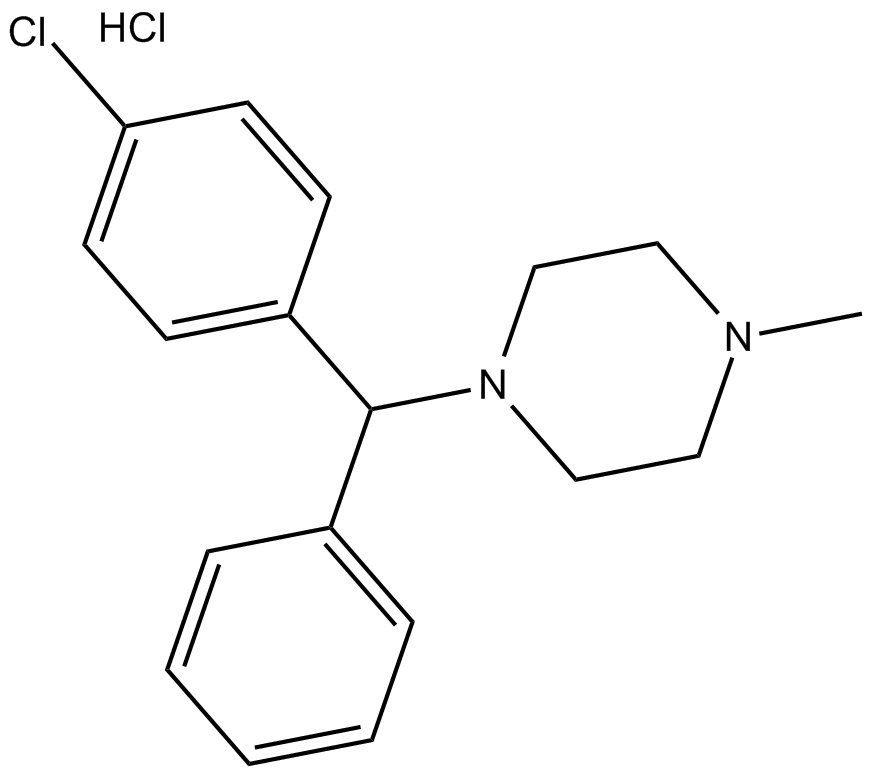Chlorcyclizine (hydrochloride) (Synonyms: NSC 169496) |
| Catalog No.GC13465 |
histamine H1 receptor antagonist and inhibits HCV
Products are for research use only. Not for human use. We do not sell to patients.

Cas No.: 14362-31-3
Sample solution is provided at 25 µL, 10mM.
Chlorcyclizine is a phenylpiperazine antagonist for histamine H1 receptor [1].
The histamine has been involved in modulating many physiological functions of the hypothalamus, such as arousal state, feeding, locomotor activity, and drinking. Histamine has been involved in circadian rhythm of locomotor activity and exploratory behavior through H1R [1].
In vitro: The Ki value of chlorcyclizine for histamine H1 receptor was 9 nM [1]. Chlorcyclizin was effective against hepatitis C virus (HCV) with an EC50 of 44 nM, preventing viral entry into host cells [2].
In vivo: In chimeric mice xenografted with primary human hepatocytes, chlorcyclizine (10-50 mg/kg) significantly inhibited infection of HCV genotypes 1b and 2a [2]. Chlorcyclizine induced a resistance to sodium pentobarbital anesthesia. Intraperitoneal injection of chlorcyclizine showed a sedative effect in small doses, but a convulsive effect in large doses. Intraperitoneal injections of the drug did not affect the recovery time from pentobarbital anesthesia [3]. In rats, pretreatment with chlorcyclizine for several days shortened the duration of action of a subsequent dose of hexobarbital, pentobarbital or zoxazolamine, and accelerated in vivo metabolism of hexobarbital [4]. The administration of chlorcyclizine (50 g/kg) to rats by stomach tube daily for 1 week resulted in significant increases in liver weight, microsomal protein concentration and the activity of the NADPH-dependent hepatic microsomal ethanol-oxidizing system (MEOS) [5].
References:
[1] Tran V T, Chang R S, Snyder S H. Histamine H1 receptors identified in mammalian brain membranes with [3H] mepyramine[J]. Proceedings of the National Academy of Sciences, 1978, 75(12): 6290-6294.
[2] He, S. ,Xiao, J.,Dulcey, A.E., et al. Discovery, optimization, and characterization of novel chlorcyclizine derivatives for the treatment of hepatitis C virus infection. Journal of Medicinal Chemistry 59(3), 841-853 (2016).
[3] Thompson I D, Dolowy W C, Cole W H. Development of a resistance to sodium pentobarbital in rats fed on a diet containing chlorcyclizine hydrochloride[J]. Journal of Pharmacology and Experimental Therapeutics, 1959, 127(2): 164-166.
[4] Conney A H, Burns J J, Michaelson I A. Stimulatory effect of chlorcyclizine on barbiturate metabolism[J]. Journal of Pharmacology and Experimental Therapeutics, 1961, 132(2): 202-206.
[5] Khanna J M, Kalant H, Lin G. Significance in vivo of the increase in micro-somal ethanol-oxidizing system after chronic administration of ethanol, pheno-barbital and chlorcyclizine[J]. Biochemical pharmacology, 1972, 21(16): 2215-2226.
Average Rating: 5 (Based on Reviews and 6 reference(s) in Google Scholar.)
GLPBIO products are for RESEARCH USE ONLY. Please make sure your review or question is research based.
Required fields are marked with *




















